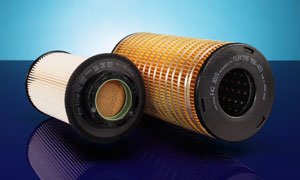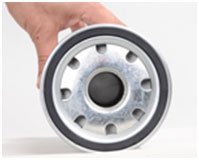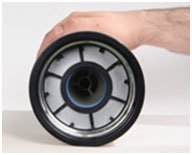The huge volume of air sucked in by a family sedan car to burn just a liter of fuel can be upwards of 2000 liters. It's only an example to make roadies aware of what goes on while your car runs. This huge volume of air is a big threat to the engine life of cars. The threats are dust, industrial fume, exhaust gases and other particles. Cleaning the air from dust particles and harmful impurities is very important for preventing the wear in the cylinders and prolonging the life of the engine.
Experts say that in order to make a diesel engine go out of operating state, just 1 gm of dust is enough. We can safely conclude that the most critical filter for a diesel engine is the air filter. In industrial zones and mining/ construction sites, the amount of dust in the air is much over 0.1 grams per cubic mtr.
Under these conditions, a motor of 100 HP, approximately sucks 85 kg of dust in a working period of 2000 hours. As this amount increase more in the construction sites depending on weather conditions and working environments, straining and filtering used in motors is obviously very important. A clogged air filter worsens the working parameters of the motor, increases fuel cost, increase the amount of exhausted gases and all these are harmful for the environment. Test results with filters having different efficiencies under conditions with high amounts of dust (200 kg/m3) are given below.

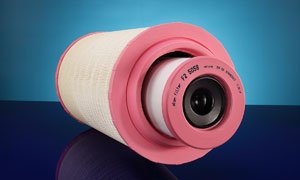
| Filter no | Efficiency | Dust amount falling on the motor (g/h) |
1 | %99,0 | 2.0 |
| 2 | %99,5 | 1.0 |
| 3 | %99,6 | 0.8 |
| 4 | %99,7 | 0.6 |
| 5 | %99,8 | 0.4 |
| 6 | %99,9 | 0.2 |
A filter with filtration effect of 99,0% passes twice more dust to the motor when compared to a filter with filtration effect of 99,5%, and when it is compared to a filter with filtration effect of 99,9%, it passes 10 times more dust. Filters are divided in to four groups as grade AA (99%), grade A (98%), grade BB (96%) and grade B (93%) according to their dust collection capacities.The road a vehicle on which a low efficiency filter is mounted will cover until the main maintenance is between 300-500 km. However this vehicle can cover 3-4 times more distance with the use of a good filter. An appropriate filter choise will also affect the wear in the motor, working parameters and cost of use.
The quality of air filters can also be determined by looking at its facing. In a good filter, the papers are placed quite properly. Pleating and placing of filter papers in a well arranged way ensures equal passing of air through all surfaces and hence increase the period of use. When the joints of paper are open, the filter is clogged with air very quickly and when it is too dense, it does not let the air pass through it. Also filters in which placements are not well arranged and equal break down more quickly and need to be replaced. In order to avoid all these situations paper should properly ve pleated and ideal number of papers needed to be placed in the filter. Also properties like type and size of the paper used, pore dimension, size and form of fibres, paper thickness, string and mechanical strength are among factors that affect the quality of the filter.
According to TS 932, there are 5 different types of air filter:
1-Dry-type Air Filter: The filter elements which carry out the straining process are composed of elements like wire mesh screen, wire wool, grain, felt, glasswool, fabric and paper. In some machines, filters with two engaged paper elements are used. This type of filters can strain 99,9% of the dust in the air. With the direction of the instructions of the producer firm of the machine, the maintenance of the filters should be made and the dust bowl should be cleaned time to time. The connections that necessitate impermeability should be checked, when the working conditions and filter indicator (dust indicator) indicate a clogging, the outer element should be cleaned with 5-6 bar pressurized air. The motor should be remounted after it is cleaned with pressurized air by applying air from inside to outside and after it is checked if there are any holes or tears in the element. In order to achieve this, a lamp with high brightness should be placed in the inner part of the filter. If there are any holes in the filter, light will pass through these holes. Such a filter should not be mounted on the motor. If no damage is detected, this filter can be used for a longer time. But it is not recommended to clean a filter with pressurized air more than three times. It should be also checked if the filter seal functions or not. The element inside is not cleaned, it is replaced with the outer element. When it is necessary, the filter element can be used after it is washed with water and dried. The dry-type air filter elements are 6 types as Type A, Type B, Type C, Type D, Type P and Type R according to their design and connection style.
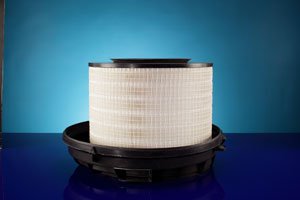
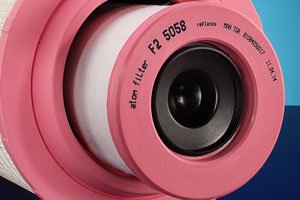
2-Oil-bath Air Filter: The air sucked by the motor, after passing through the pipe in the filter, brushes the oil in the filter vessel and the foreign matters in it are held by the oil. Also it drags some oil as grains with itself. The wire mesh screen at the outlet of the filter holds this oil and prevents it to go into the motor, also the dust particles in this air are held by this wire mesh screen and separated from the air. The cleaned air passes through the inlet manifold and goes to the cylinder. The oil which contains the dust particles held by the wire mesh screen is filtered and goes back to dust collecting ail pot. For this type of filters to filter well, the oil in the pot should regularly replaced and should be filled according to its level. The size of the oil vessel is related to size of the motor. The maintenance of these filters are more difficult. The oil should be drained when the mud sediment in the oil vessel reaches a height of 1-2 cm, the oil vessel and wire mesh screen should be washed with diesel fuel and oil having the quality and viscosity which the motor uses should be added upto the level line. Worked and rested motor oil can be added too. Wire mesh screen whose wires are disconnected and teared apart should definitely be replaced. For the maintenance of the filter, actions should be taken according to the instructions of manufacturing or operating firm by also considering the working conditions. The oil-bath air filters are divided into 3 type according to the position of air outlet as:
-Air outlet from bottom (T1)
-Air outlet from top (T2)
-Air outlet from the sides (T3 and T3A)
3- Filled Air Filter: It functions by filtering the air by means of oiled filling materials.
4-Mixed Air Filter: By combining two or more dry cyclone and oil-bath air filters appropriately, it ensures the particles in the air to be separated.
5- Cyclone Air Filter: It enables dust in air to be separated from the air by rotational motion and to precipitate and it is functionally an auxiliary pre-filter for the main filter which is used before dry or oil-bath air filters.
6-Air Filter with Muffler: It is an air filter which attenuates the noise which the air entering the filter creates with the help sound attenuator equipment with special form and dimension which is placed to the inlet part of the filter.
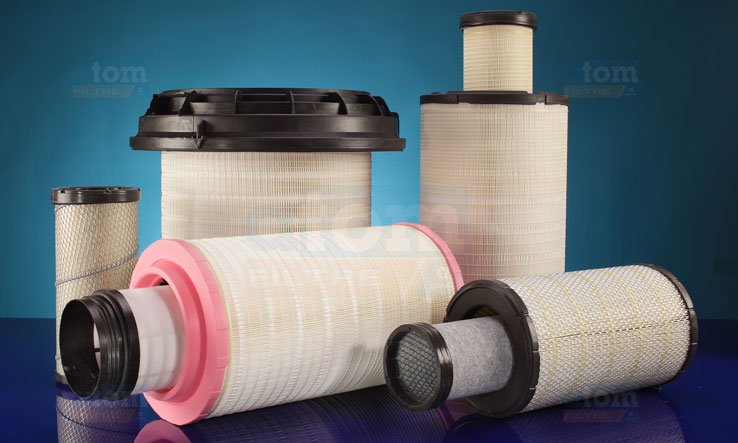
-Expectations from a good air filter:
-It should be able to hold particles with undesired diameter which go to the combustion chamber of the motor and which are directly related to motor characteristics.
-The resistance of the filter for the air flow and the increase of the resistance as a result of contamination should be as low as possible.
-The flow in the air flow line should be eased.
-Mounting, demounting and maintenance should be easy.
-It should work with the desired efficiency even in extremely dusty and moist environments.
-As sound waves are also created during the air inlet, air filter should also function as an inlet filter.
-The filter paper should be pressure resistant.
-In order to increase the resistance of the filter and to prevent the filter paper to go to the motor, galvanized perforated coverings made of sheet metal should be placed to the inner and outer surfaces of the filter element.
After working some time, dust is accumulated on the surface of the air filter and this causes a degree of clogging. This particular amount of clogging causes a pressure difference, and this affects the output power of the motor. The lifetime of the filter increases or decreases depending on the working environment (dust and relative humidity percentage in the air), the diameter of the particle to be held (dust, coal, soil, etc.), and the air flow rate (required air volume in unit time).
Filters should be replaced more often in places with high amount of dust. In some vehicles, there exists a sensor which indicates the dustiness degree of the air filter and when it is necessary to replace the filter.
A simple filter has a structure sealed from top and botton parts and placed in a metal container which forms the shank. In some type of filters, in order to increase the resistance of filter element, galvanized plates made of perforated sheet metal and supporting rods are added. This plates are used both for increasing the strength of the filter and for removing the large particles that might enter the filter paper from outside.
In some load trucks and buses, instead of a single filter, two filters are used and one of these is placed in the other. The filter inside is called protective filter. When the filter is extremely polluted, the absorbing power of the motor is enough the tear up the filter. When the main filter is teared, the protective filter protects the motor from dust and dirt and ensures reaching to the nearest service where a new main filter can be mounted. The efficiency of the protective filter is approximately 70%. The protective filter should be replaced after the main filter is replaced three times.
For some type of vehicles, propeller air filters are used. The props ensure the preliminary treatment of the air. They also help for the air inlet circulation to be more balanced and decreasing the sound caused by the air flow. In these systems, the air flow absorbed by the motor are rotated by the props and with the effect of centrifugal force, big sized dirt are collected in special collection place with the help of internal walls. These type of filters are used in equipment and machines which are used under conditions in which the air is extremely polluted (in mines, agriculture, construction).
Impermeability is important for ensuring the whole air flow to pass through the filter. In PUR and PCV sealed air filter elements the seal part will provide the impermeability at positions whre the filter is mounted on the motor. The seal part of these filters should be in solid and homogeneous structure in which the air gap is minimized. Also in these types of air filters, the sheet weldings on which the complete air filters are mounted should be at sufficient level in terms of permeability.
Source: AFM Filtration, manufacturers of Atom brand of filters

